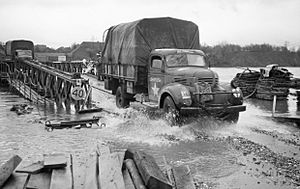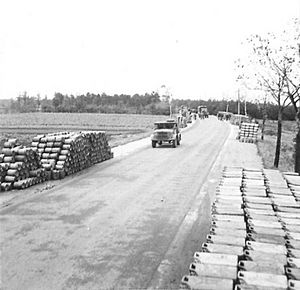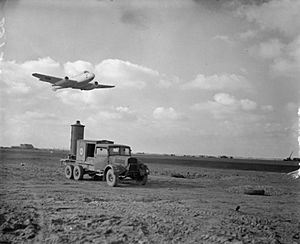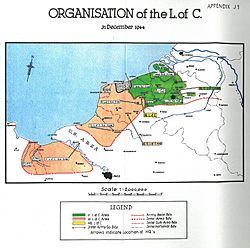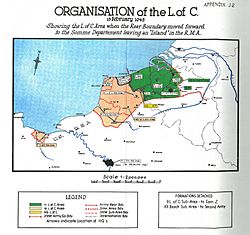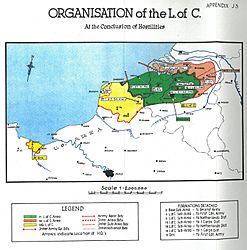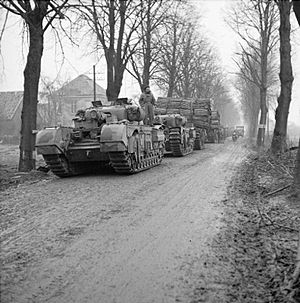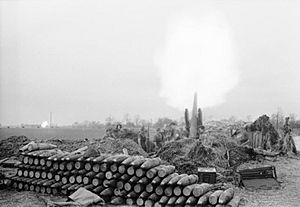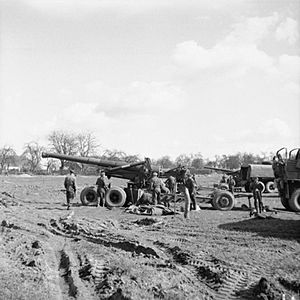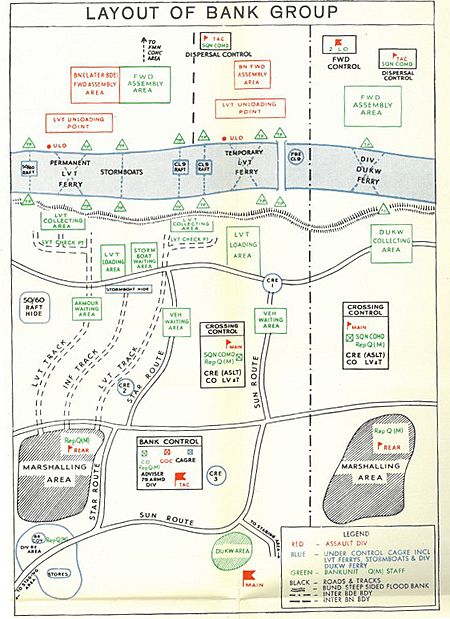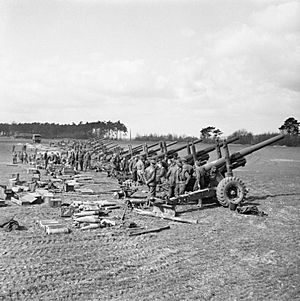British logistics in the Western Allied invasion of Germany facts for kids
British logistics played a huge role in helping the British and Canadian armies during the final push into Germany in 1945. This was during the last part of World War II in Europe, from January to May 1945. To win battles, these armies needed lots of supplies like ammunition, fuel, and equipment. This meant they needed a super efficient way to get everything where it needed to go. By this time, the British Army was very experienced and good at this.
A big attack called Operation Veritable was supposed to start in January 1945 when the ground was frozen. But it was delayed for five weeks because the Germans launched their own attack, the Ardennes Offensive. So, when the attack finally happened, the ground was muddy and flooded, making roads hard to use. Even special four-wheel-drive vehicles struggled!
This attack used 600 field guns and 300 medium guns. Over 2.5 million rounds of ammunition were ready. Most supplies reached the army by train. Fuel came by ships and a special pipeline from the UK. It was then moved by barges and smaller pipelines. Even the Royal Air Force (RAF) needed special fuel. For example, a system to clear fog from airfields used 90,000 gallons of fuel each night! Jet fighters, like the Gloster Meteor, needed 3,000 gallons of kerosene daily.
Later, a huge operation called Operation Plunder involved crossing the Rhine River on March 23. For this, the British and US armies used thousands of guns. Many engineers, about 37,000 British and Canadian, and 22,000 American, helped. They gathered every type of boat they could find. Even the Royal Navy sent landing craft, which were driven all the way across Holland and Belgium by road! This operation also included an airborne attack where soldiers parachuted in with a day's worth of food and fuel. Engineers quickly built bridges over the Rhine, which were later replaced by stronger ones.
In April 1945, the armies advanced about 200 miles across northern Germany. They reached the Elbe River on April 19 and then the Baltic Sea. At first, all supplies had to move by road because the railway bridges were broken. The army moved vehicles from other areas to help. Sometimes, army groups had to send their own trucks back to get supplies. All this driving meant the British Second Army used 7,500 tons of petrol every day! But pipelines were built across the Rhine, helping with fuel delivery. On May 4, the German forces facing the British army surrendered.
Contents
How Logistics Helped the Army
The 21st Army Group, led by Field Marshal Sir Bernard Montgomery, was the main British and Canadian force. It included the First Canadian Army and the British Second Army. Soldiers from Belgium, the Netherlands, Czechoslovakia, and Poland also joined them. Even the RAF had pilots from Australia, France, New Zealand, and Norway. But all the supplies and support came from the British.
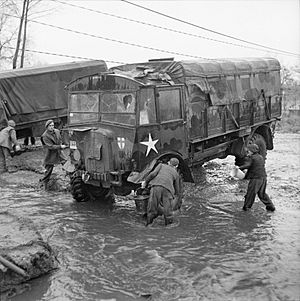
The campaign in Europe started with Operation Overlord, the D-Day landings in Normandy in June 1944. The Germans fought hard, and the advance was slow at first. But then, the American Operation Cobra broke through, and the armies moved much faster. The British Second Army freed Brussels on September 3 and captured Antwerp on September 4. Antwerp was a very important port. However, it couldn't be used until the Germans were cleared from the Scheldt River, which ships had to use to reach the port. This took a big battle, and the port finally opened on November 26.
New supply bases were set up near Brussels and Antwerp. But supplies still came from the main storage area in Normandy. To get the trains working again, bridges had to be rebuilt, and more train engines were brought in. Fuel arrived by ships and through the Operation Pluto pipeline from the UK. Many French, Belgian, and Dutch civilians helped at the bases. They did many jobs, freeing up soldiers for fighting. By January 1945, about 90,000 civilians worked for the 21st Army Group.
During the German attack in December 1944, the US First and Ninth Armies were placed under Montgomery's command. After the German attack was stopped, the US First Army returned to American command. But the US Ninth Army stayed with the 21st Army Group until April. Even though these US armies were under British command for battles, their own US logistics teams handled their supplies.
By the end of 1944, the Allies decided to focus their main attack in the north, where the 21st Army Group was. This area had the best places to cross the Rhine. It also led to the North German Plain, which was good for fast-moving battles. This strategy also helped cut off the Ruhr, Germany's main industrial area.
Moving Troops from Italy
At a big meeting in January 1945, the Allies decided to send more troops to Europe from the Mediterranean area. This was called Operation Goldflake. It involved moving two Canadian divisions and three British divisions from Italy to North-West Europe. This was a huge move, involving over 100,000 soldiers!
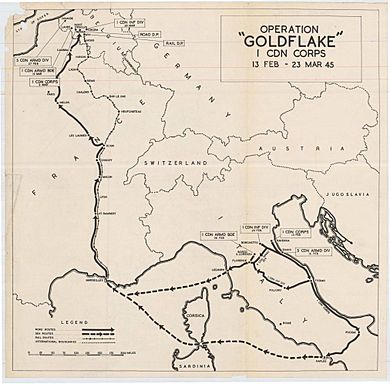
To prepare for these new troops, the 21st Army Group asked for more supply depots and bakeries. But they couldn't get all of them. They had to make do with what they had. In May 1945, the 21st Army Group had 25 main supply depots, 81 smaller ones, 35 field bakeries, and 14 field butcheries.
Most of the troops moved by sea. They sailed from Naples to Marseilles, France. From there, trucks took them on a five-day journey to their new locations in Belgium. Special road signs marked "GF" (for Goldflake) guided them. Trains also helped move many soldiers and vehicles. For example, four trains a day passed through one station, carrying over 72,000 people and 4,000 trucks.
Heavy equipment like tanks and carriers were loaded onto trains in Italy, then onto landing ships to cross the sea to Marseilles, and then back onto trains for the journey to Belgium. Many tanks needed repairs after the long trip, but replacements were ready. All these movements were finished by early April.
Fueling the Advance
Keeping the Tanks Rolling
In January 1945, the British army had enough fuel for 58 days. This was more than the 30-day reserve they were supposed to keep. So, they shared some fuel with the Americans.
The main port for fuel was Ostend, Belgium. It was connected by pipeline to a huge fuel storage area in Ghent. Antwerp also had a lot of fuel storage, shared with the Americans. Fuel was also stored in drums and cans at other locations.
A pipeline from Dungeness in the UK to Boulogne in France, called Operation Pluto Dumbo, was now working. More pipelines were built from Calais to Ghent and then to Antwerp. By mid-March, 15,000 tons of fuel arrived every day.
Special companies with trucks distributed the fuel. They were reorganized to be more efficient, saving vehicles. The army also used barges on canals to carry 10,000 tons of fuel.
There were different types of petrol depots to store and issue fuel in cans or drums. Some were large, holding up to 12,500 tons, while smaller ones held 2,000 tons. By May 1945, the 21st Army Group had many of these depots and transport companies.
A system called FIDO (Fog Investigation and Dispersal Operation) at Épinoy used a lot of fuel, about 90,000 gallons each night, to clear fog from airfields. Jet fighters also needed special kerosene. A German V-2 rocket hit a British fuel storage area in Antwerp, causing a fire and destroying some tanks. After this, they decided to remove camouflage from the tanks because it made firefighting harder.
Organizing Supplies
To support the advance into Germany, the army decided to close the main supply area in Normandy. About 300,000 tons of supplies were still there, including 15 million food rations. These supplies were gradually moved forward to new advanced bases.
The British army reorganized its supply zones. Areas south of the Seine River were handed over to the US forces. This freed up British supply units to move closer to the front lines and help with Operation Goldflake.
The army estimated they would need seven main supply headquarters to support the advance into Germany. They could only provide three at first, so the War Office created a new headquarters and four more supply zones. This helped manage the huge amount of supplies needed for the fighting.
Operation Veritable: The Rhine Advance
Planning the Attack
Operation Veritable was supposed to start in January when the ground was frozen. But it was delayed by five weeks due to the German attack. By then, the weather had warmed up, and the ground was soft and muddy. This made it hard for vehicles to move off-road. The First Canadian Army, with many British troops, had almost 450,000 soldiers for this operation.
This operation was a pincer movement, meaning two forces would attack from different sides to trap the enemy. The British XXX Corps led Operation Veritable. Another US army would attack from the south.
The artillery plan for Operation Veritable used "pepperpot tactics." This meant using many different types of guns, including anti-tank guns, anti-aircraft guns, mortars, and machine guns, to saturate an area. This used a lot of ammunition, especially for certain types of mortars and machine guns.
The amount of shells fired was huge. Some targets received up to 11 tons of shells! About 600 field guns and 300 medium guns supported the attack. Over 2.5 million rounds of 25-pounder ammunition were made ready. Ammunition was stored at special centers. There were 350 different types of ammunition in total.
A railway bridge over the Maas River opened on February 4, making it easier to bring supplies by train. This also helped bring stone for road repairs. About 50 miles of new roads were built, and over 400 miles were repaired, using 63,000 tons of road material. Before Operation Veritable, 446 special trains brought 343,838 tons of supplies to the Canadian army's railheads.
Winter weather made road maintenance tough. Temperatures dropped very low, freezing the ground, but then a thaw caused widespread flooding. Sections of roads became impassable. Nearly 50 engineer companies and 29 pioneer companies worked on road maintenance. Four main roads were available for troop movements, using bridges over the Maas River.

Soldiers were given special "compo" ration packs and 24-hour ration packs. They also got "Tommy cookers" and tea supplies to make hot drinks. Assault units carried five days of supplies, and armored divisions carried six. This gave them enough fuel to advance for 200 miles, even though a fast advance wasn't expected. The fuel was to keep them going if roads became too busy.
Special tracks were given to some vehicles to prevent skidding on ice, but they caused too much wear and tear. Sherman tanks got "duck bill" connectors on their tracks to help them move on snow and soft ground. These were made in Brussels. Soldiers also received Arctic clothing and equipment because of the cold. Covered shelters were provided for 300,000 to 400,000 troops.
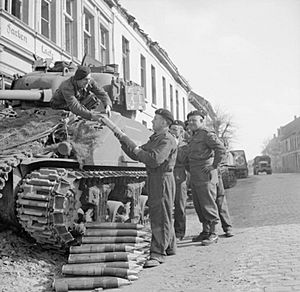
The British XXX Corps found that the Canadian army's supply methods were different. The Canadians sent supplies directly from the main base to corps railheads, which stored specific items like ammunition or fuel. This saved on road transport but made things less flexible. The XXX Corps had to get more transport vehicles from its own divisions. They also prepared amphibious trucks like DUKWs and Terrapins in case the Germans flooded the area.
The Battle Begins

Once the battle started on February 8, the main job was to resupply ammunition. Since the Canadian army didn't keep huge stocks, they relied on daily ammunition trains. But the army used more ammunition than a single train could carry. So, if a train didn't arrive, they had to get ammunition from other army depots. It was important to unload trains quickly so they could return for more supplies. Ammunition was used so fast that a rationing system had to be introduced.
Rising floodwaters caused problems. Roads were under 18 to 24 inches of water. DUKWs were used to move supplies through the flooded areas. Some ammunition that had been stored earlier became unreachable due to the floods. The roads also got very bad because of traffic, thaws, and heavy rains. Tracked vehicles like Weasels were rushed to the front to help. Many of these vehicles had been used hard before, so they needed emergency repairs.
The Canadian Corps took over the left side of the battle on February 15. When the floodwaters went down, the Nijmegen-Cleve road was too damaged to use. So, the two corps had to share a single road. The XXX Corps returned to British Second Army control on March 8. By March 10, the last German units had retreated across the Rhine. Repairs to a long bridge over the Maas River at Gennep on March 20 helped ease the pressure on road transport.
Operation Plunder: Crossing the Rhine
Getting Ready to Cross
With the port of Antwerp open, some supplies now came directly from the United States. The longer shipping time meant they needed a 30-day supply reserve. The army also expected to feed many prisoners of war and displaced people as they advanced into Germany. So, they asked for more reserves, and the War Office approved. However, they couldn't increase ammunition stockpiles because it was already being shipped as fast as it was made.
The next big operation was Operation Plunder, the attack to cross the Rhine. The British Second Army used 1,520 field and medium guns, and the US Ninth Army used 624. They also had thousands of anti-aircraft and anti-tank guns. Ammunition for the 25-pounders was planned at 1,500 rounds per gun. In the three days before the attack, one corps fired hundreds of thousands of shells. Up to seven trains a day were needed to bring ammunition to the front. A smoke screen was used to hide the preparations on the west bank of the Rhine.
A huge number of engineers were gathered: 37,000 British and Canadian, and 22,000 American. They collected every available amphibious vehicle, like DUKWs, Buffaloes, and DD tanks. The Royal Navy even sent landing craft (LCMs and LCVPs) that were transported by road across Holland and Belgium to join the operation. These boats were so tall on their trailers that they barely fit under some bridges! Special trailers had to be built to give them more clearance.
Stockpiling supplies for Operation Plunder began on March 8. During that month, 432 trains delivered 230,000 tons of supplies to 37 railheads. By the time the crossing started on March 23, 60,000 tons of ammunition, 18,000 tons of fuel, and many other supplies were ready. Units participating in Operation Plunder were re-equipped. Special trains brought needed items to the front quickly. Even new Comet tanks had a defect, and new parts were flown directly from the UK factory.
The Crossing and Beyond
Two airborne divisions, the British 6th Airborne Division and the US 17th Airborne Division, parachuted in to support Operation Plunder. They were supplied by air, with 80 percent of the dropped supplies recovered. These supplies included a day's worth of food, fuel, and petrol. Once they linked up with ground forces, they got supplies from the main army groups.
Canals were opened to allow barges to transport supplies. The road network was also improved, with eleven routes open across the Maas River. Engineers built many bridges, including Bailey bridges, which are temporary, portable bridges. Seven American engineer battalions helped with road and bridge maintenance in the British Second Army area. The final troop movements for Operation Plunder involved 662 tanks, over 4,000 tank transporters, and 32,000 other vehicles.
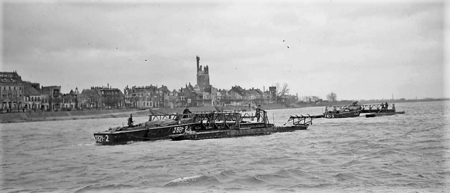
Vehicles crossing the Rhine had full fuel tanks and extra fuel in cans. Additional fuel was ferried across by DUKWs until bridges were open. Each soldier got a 24-hour ration, an emergency ration, and a small cooking kit. Divisions carried several days' worth of food rations.
Assault divisions set up small supply points on the west bank of the Rhine. From here, urgently needed equipment and spare parts could be sent across by DUKW. Damaged vehicles on the east bank were collected and brought back on rafts. Special "bank control groups" managed all movement from the assembly areas to the other side of the Rhine.
The first British bridge across the Rhine, a class 9 FBE bridge called "Twist," was built in ten hours on March 24. Another bridge, "Sussex," took 43 hours. A class 40 Bailey pontoon bridge at Xanten was built in 31 hours and opened on March 25. Over the next six days, 29,139 vehicles used it. More bridges were built quickly.
It was clear that the floating bridges over the Rhine would need too many engineers to maintain. So, it was decided to replace them with more permanent bridges as soon as possible. These would be made of wood or steel piles. Trees were cut down near Brussels for the wooden piles. Special vehicles were built to carry these huge piles. Eventually, three semi-permanent class 40 bridges and two class 70 bridges were built over the Rhine.
Beyond the Rhine: The Final Push
In the first three weeks of April 1945, the British Second Army advanced about 200 miles across northern Germany. They reached the Elbe River on April 19. During this advance, they had over 7,600 casualties but captured over 78,000 prisoners. Until railway bridges were fixed, all supplies had to move by road. The 21st Army Group sent more trucks to the Second Army.
New supply points were set up further east. Trains started arriving at these points using an American rail bridge. German railway workers were even used to run some trains. This expansion of the rail network allowed the 21st Army Group to give the Second Army even more road transport.
Despite this, supplies at the forward depots were running low. Army groups sometimes had to send their own trucks back to the Rhine to pick up ammunition for big battles. The Dumbo pipeline was extended from Boulogne to Antwerp in March. Two pipelines were also laid across the Rhine at Emmerich and were working by the end of April. By mid-May, the 21st Army Group's fuel reserves had been reduced by a quarter.
The Dumbo pipeline system grew to 1,125 miles of pipelines and huge storage tanks. To ease pressure on roads, the 21st Army Group also used aircraft to deliver supplies. However, this didn't reach its full potential because of other demands, like flying liberated prisoners of war home.
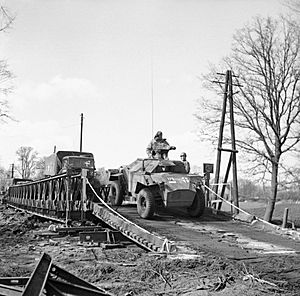
Meanwhile, the First Canadian Army also set up its own supply lines. They advanced towards Utrecht and Oldenburg. Emmerich was captured on April 1, providing another bridgehead. Three bridges were built there, but the Canadian divisions had already crossed the Rhine.
As the German forces collapsed, the number of German prisoners of war grew so large that orders were given not to send any more west of the Rhine. Later, these disarmed soldiers were no longer called prisoners of war but "Surrendered Enemy Personnel." They were to be managed by their own officers. Captured German food was used to feed them, but sometimes the British Army had to provide food. Many displaced people were also found and housed in special camps, where they received care and food. By May, the number of people the 21st Army Group was feeding had risen to 1.7 million.
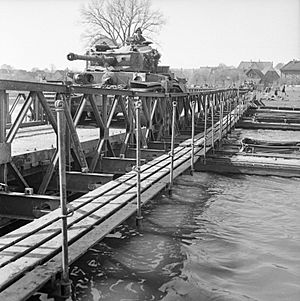
On May 4, 1945, Field Marshal Montgomery accepted the surrender of German forces in the Netherlands, North-West Germany, and Denmark. Four days later, the official German surrender was signed in Berlin, and the war in Europe was over.
After the War
Rebuilding Germany
Civil affairs supplies, mostly food, soap, and medical items for civilians, were given out through military channels. The British zone in Germany included the Ruhr industrial area. Major-General Gerald Templer became the Director-General of Civil Affairs in March 1945. He knew that Germany faced a huge humanitarian crisis unless food, shelter, and fuel were provided to the people.
The British zone, especially the Ruhr, couldn't feed itself. Before the war, it imported millions of tons of food from eastern Germany, which was now under Soviet control. The transportation system had collapsed due to Allied bombing, stopping food from moving. Even butter production stopped because there wasn't enough coal.
Fixing Germany's transportation was a top priority. Port control groups were set up in cities like Emden, Hamburg, and Lübeck. Finding staff for these groups was hard because many skilled officers were being sent home or to fight in the war against Japan.
The railway system needed a lot of work. Many bridges were destroyed. By October, about 22 percent of the railways were working again. Roads also suffered from destroyed bridges. The Royal Engineers led the effort to repair or replace 1,500 bridges. Army workshops worked to get vehicles back into service.
The British zone had coal, but the number of miners had fallen sharply. The 21st Army Group worked to restart the coal industry. There was also a shortage of wooden supports for the mines. The British Army helped get timber from other areas and transport it to the mines.
What Was Achieved?
In the 1945 campaign in North-West Europe, Montgomery wanted to defeat Germany and show a strong British role. This was important for Britain's place in Europe after the war. It wasn't easy because the British army was much smaller than the American armies and had a shortage of soldiers. To make up for this and keep casualties low, the British forces relied heavily on machines, equipment, and firepower.
The huge resources used were very different from the shortages at the start of the war. Aid from the United States and strong industrial production provided the equipment. The British Army in 1944–1945 was highly mechanized, which meant it could move quickly and strategically. But this also required excellent organization and skilled professionals to use the machines and firepower effectively. In this campaign, the British Army showed how good it was at logistics. The 21st Army Group's supply system successfully kept the soldiers fed and supplied, even in the terrible weather of Operation Veritable and during the fast advance beyond the Rhine.


